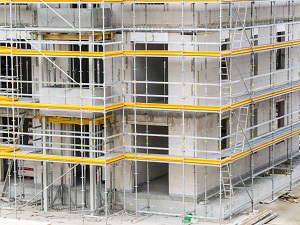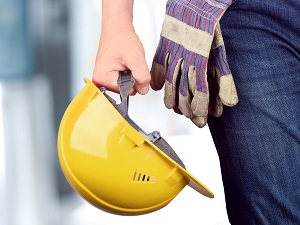Construction workers are exposed to hazards throughout the course of their work day. Review this list for some of the more common construction site hazards along with guidance on specific items that need to be included in the construction company's workplace safety program.

According to OSHA, the leading causes of private sector worker deaths in the construction industry are falls, struck-by hazards, electrocution and caught-in hazards. These Top 4 most fatal hazards are responsible for more than half of all the construction worker deaths that occur annually. Construction work is one of the most dangerous occupations in America and even the most careful worker can be injured on an active worksite. Other work accidents and injuries that are common on construction sites are caused by other factors including falls from heights, collapses of trenches and scaffolds, electric shock, arc flashes or blasts, repetitive motion, and failure to use the proper personal protective equipment and devices.

Most Common Hazards on Construction Sites
Scaffolding Hazards. Falls occur when scaffolding is not assembled and/or used correctly. OSHA estimates that if correct protective methods were used, about 4,500 injuries and over 60 fatalities could be prevented annually.
Fall Hazards. Falls represent the biggest fatal hazard to construction workers. Falls may occur due to unstable work surfaces, human error, and misuse of or failure to use protection equipment.
Ladders and Stairway Hazards. Ladders and stairways are involved in injuries and fatalities each year on construction sites. Stairways are associated with trips and falls.
Trenching Hazards. Injuries and fatalities often occur on construction sites due to trench collapses.

Crane Hazards. Cranes require regular inspections and correct use to prevent serious work accidents. Typical injuries involve workers being hit by an overhead load or trapped in the crane's swing radius.
Hazard Communication. Workers are often injured due to failure to communicate hazards involving chemicals, fires, explosions, and respiratory problems.
Forklift Hazards. OSHA estimates that about 95,000 forklift operators are injured every year, and another 100 are fatally injured annually.
Head Protection Hazards. Blows to the head can result in serious head injuries. All workers must wear hard hats in construction areas.

Construction Site Safety Tips
All employees must wear proper protective gear (PPE). Require the use of safety glasses or face shields for work operations that may result in foreign objects entering the eyes. Choose eye and face protection according to the hazards involved. Construction workers should wear slip-resistant shoes or boots that have puncture-resistant soles and safety toes. Gloves must fit snugly and must be suited to the job.
Ensure electrical safety. Always shut off power and attach grounds for new or existing energized electrical circuits before working on them. Replace damaged electrical cords and cables promptly. Use extension cords with grounding prongs, and never bypass protective systems when using electricity. Keep equipment, ladders, and scaffolds away from overhead power lines. Never use multiple plug adapters.

Choose and use equipment and tools correctly. Scaffolds, for example, must be strong enough to hold four times the maximum intended load without shifting or displacing, and they must be assembled on solid footings. Choose the correct ladder for the job. Do not use metal ladders near overhead power lines or for electrical work. Never exceed load capacities of trenches, ladders, stairways, cranes, and scaffolding.
Inspect equipment and tools regularly. Perform regular inspections of equipment and apply fixes and repairs promptly. Remove or label defective and malfunctioning equipment as soon as discovered. Perform prompt inspection of equipment such as trenches and scaffolding after vibrations and rainstorms. Fix slippery conditions on stairways promptly.

Handle chemicals properly and communicate any potential hazards. Communicate hazards involving chemicals, fires, explosions, and respiratory problems. Train employees to use Safety Data Sheets (SDS). Follow all SDS instructions for chemicals. Install cleanup kits near chemical areas and create written spill control plans, and train employees in cleanup procedures. Make sure to store chemicals safely.
Ensuring a safe and efficient work environment for construction workers must be given utmost importance and resources. It may be tempting to cut corners to save costs, but it is in everyone’s best interest to follow all safety precautions at all times.


